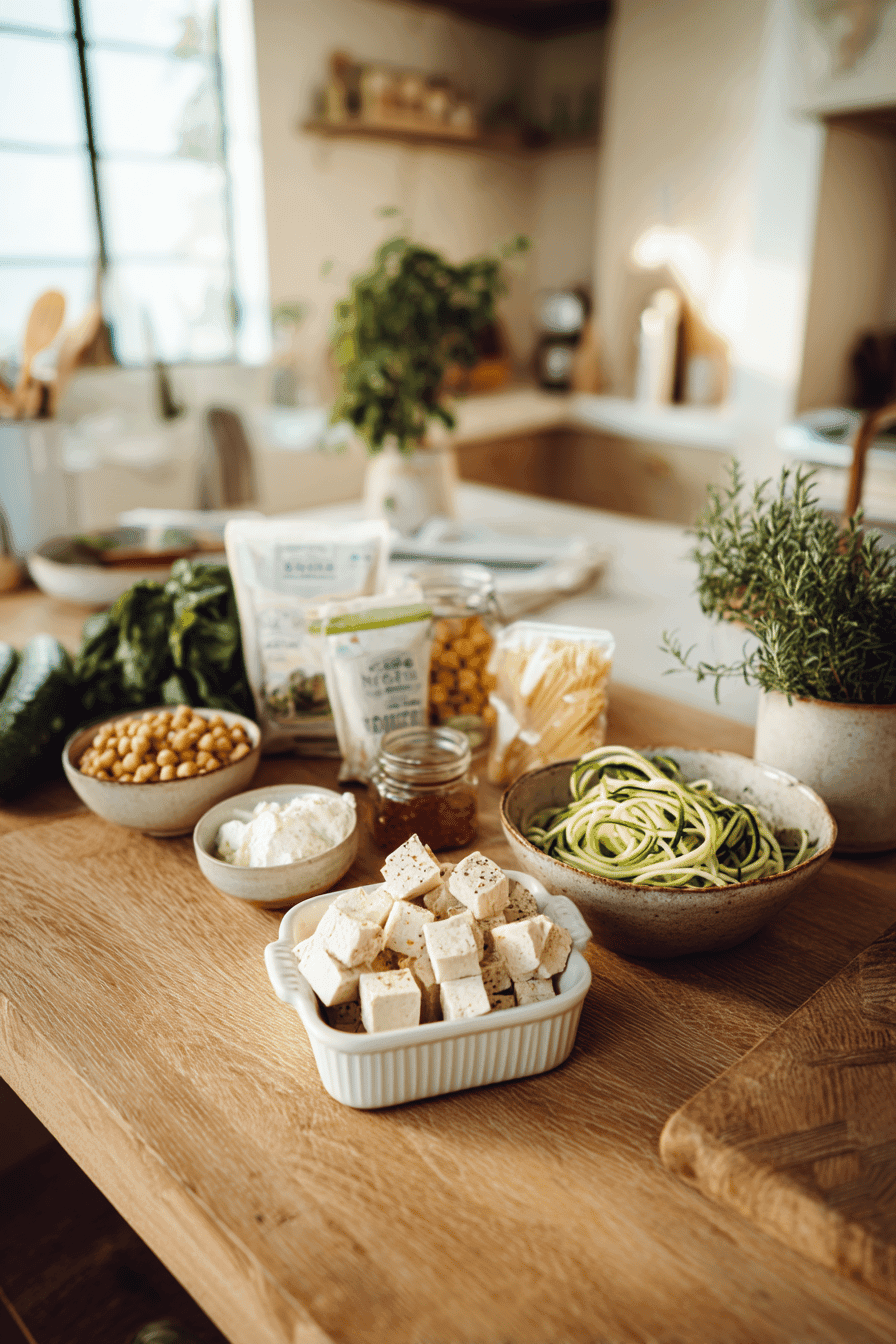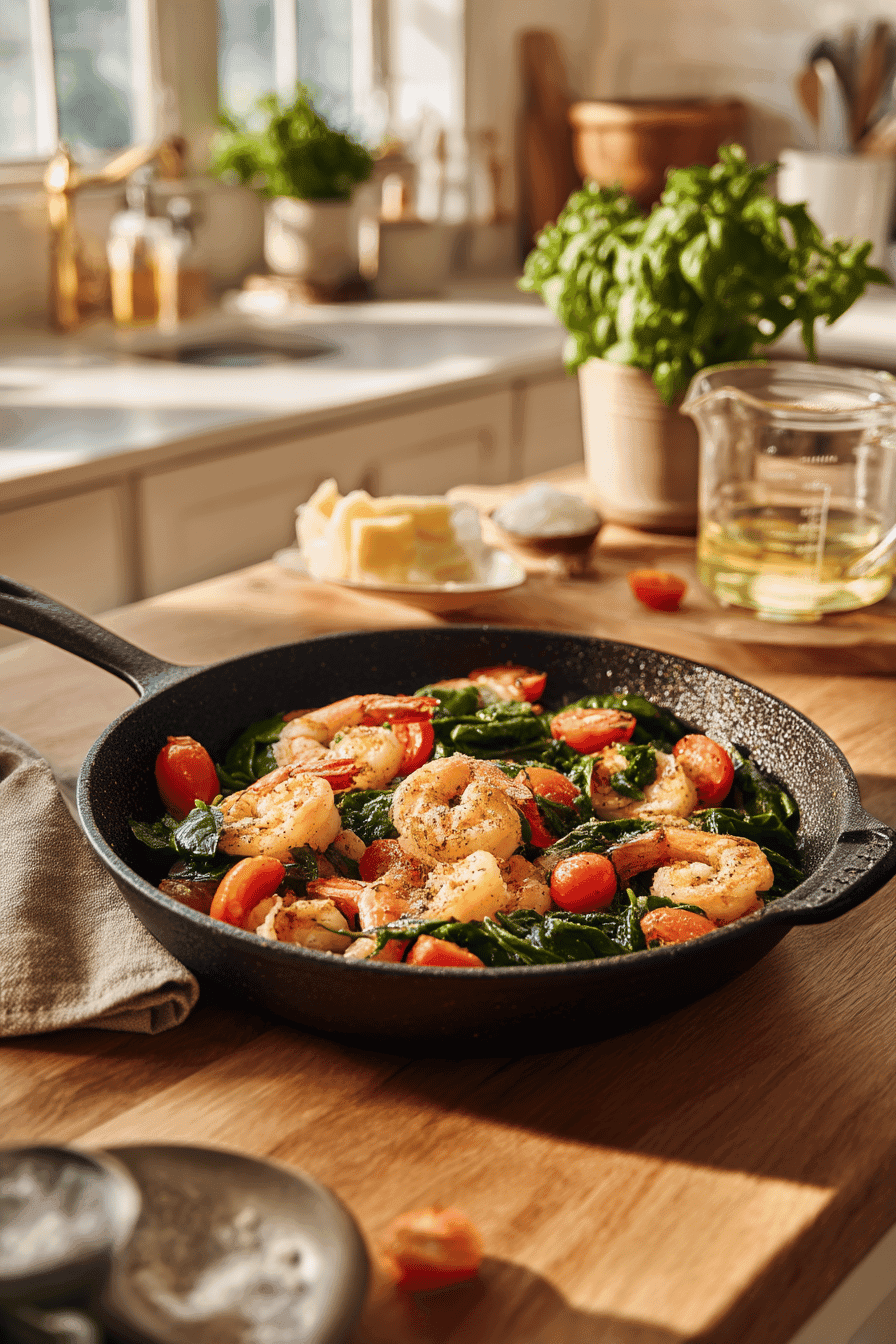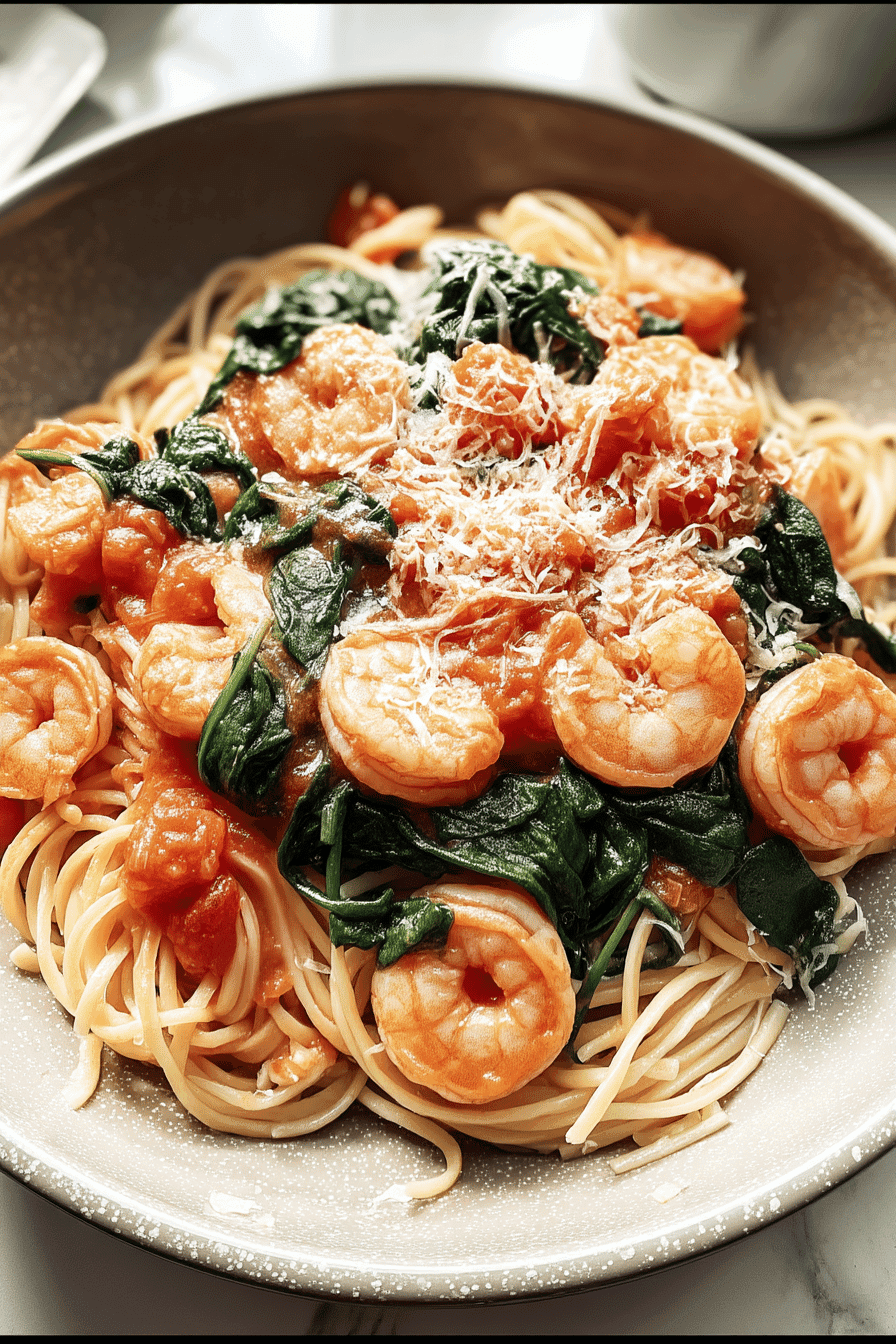Benefits and Advantages of Tomato Spinach Shrimp Pasta
Tomato spinach shrimp pasta is a flavorful and nutritious dish that offers numerous benefits, making it a favorite for busy home cooks and food enthusiasts alike. This recipe is simple to prepare, requiring straightforward ingredients and basic cooking steps that suit both novice and experienced cooks. The shrimp provides a lean, high-quality source of protein rich in omega-3 fatty acids, which support cardiovascular health and cognitive function. Spinach contributes essential vitamins such as A, C, and K, along with minerals including iron and calcium to support bone health and immunity.
Fresh tomatoes add natural sweetness and acidity, delivering antioxidants like lycopene, known for its anti-inflammatory properties. Together, these components create a balanced, wholesome meal that is light yet satisfying, perfect for a quick weeknight dinner or a crowd-pleasing recipe for gatherings. The garlic and olive oil enrich the dish with heart-healthy fats and an inviting aroma, while the Parmesan cheese adds a flavorful finishing touch. Unlike heavier pasta meals, this dish maintains a fresh, wholesome profile that aligns well with health-conscious eating without sacrificing taste or satisfaction.
“This tomato spinach shrimp pasta combines vibrant flavors and nutrition in a fast, one-pot meal perfect for any season.”
Jump to:
- Benefits and Advantages of Tomato Spinach Shrimp Pasta
- Essential Ingredients for Tomato Spinach Shrimp Pasta
- Dietary Substitutions to Customize Your Tomato Spinach Shrimp Pasta
- How to Prepare the Perfect Tomato Spinach Shrimp Pasta: Step-by-Step Guide
- Mastering Tomato Spinach Shrimp Pasta: Advanced Tips and Variations
- How to Store Tomato Spinach Shrimp Pasta: Best Practices
- Nutritional Value of Tomato Spinach Shrimp Pasta
- FAQs: Frequently Asked Questions About Tomato Spinach Shrimp Pasta
- What ingredients do I need to make tomato spinach shrimp pasta?
- How long does it take to cook tomato spinach shrimp pasta from start to finish?
- Can I make this recipe gluten-free or adjust it for dietary needs?
- What is the best way to store and reheat leftover tomato spinach shrimp pasta?
- Garlic Butter Shrimp Pasta with Spinach and Tomatoes – Easy One-Pot Recipe
- Ingredients
- Instructions
- Last Step:
- Notes
- Nutrition
- Did you make this recipe?
Essential Ingredients for Tomato Spinach Shrimp Pasta
Creating a delicious tomato spinach shrimp pasta involves a well-balanced list of fresh and pantry ingredients. Below are the critical components that contribute to the dish’s signature taste and texture:
- 8 ounces (about 225 grams) uncooked spaghetti (gluten-free options available)
- 1 pound (about 450 grams) uncooked shrimp, peeled and deveined (tails optional)
- 1 tablespoon extra virgin olive oil
- 2 to 4 tablespoons butter (adjust based on preference)
- 4 to 5 cloves garlic, minced
- 10 ounces (about 280 grams) grape tomatoes, halved or 5 medium fresh tomatoes chopped
- 1/4 cup (60 ml) chicken broth or low sodium vegetable broth (dry white wine such as pinot grigio can be used for extra flavor)
- 1/4 teaspoon Italian seasoning
- 1/4 teaspoon salt, plus extra to taste
- Freshly ground black pepper to taste
- 1/4 teaspoon paprika (optional, for enhanced flavor)
- 1/2 teaspoon crushed red pepper flakes (optional, adjust for heat preference)
- 2 to 5 cups fresh baby spinach (packed) or 1 cup cooked spinach
- 1/2 cup grated Parmesan cheese, divided for serving and finishing
- Freshly squeezed lemon juice (about 1/4 to 1/2 small lemon, optional for brightness)
Each ingredient plays a vital role: shrimp provides tender protein, spinach adds earthy freshness and nutrients, tomatoes lend natural acidity and sweetness, and the garlic butter sauce ties together all components beautifully. These ingredients also enable easy substitutions for dietary needs without sacrificing flavor.

Dietary Substitutions to Customize Your Tomato Spinach Shrimp Pasta
To accommodate diverse dietary preferences and restrictions, several simple substitutions keep this tomato spinach shrimp pasta inclusive and delicious:
- Vegetarian or Vegan: Replace shrimp with firm tofu, tempeh, or chickpeas for a plant-based protein boost.
- Gluten-Free: Use gluten-free pasta varieties such as brown rice pasta or legume-based noodles to ensure safety for gluten-sensitive individuals.
- Low-Carb or Zucchini Noodles: Substitute traditional pasta with spiralized zucchini or shirataki noodles for a lighter, low-carb meal without compromising texture.
- Dairy-Free: Omit Parmesan cheese or use nutritional yeast to replicate cheesy flavor without dairy.
- Low-Sodium: Opt for no-salt-added canned tomatoes and reduce added salt during preparation.
- Shellfish Allergies: Swap shrimp for white fish such as cod or chicken breast pieces as a safe alternative.
By embracing these substitutions, cooks can maintain the dish’s core flavor profile while respecting individual nutritional needs and preferences.

How to Prepare the Perfect Tomato Spinach Shrimp Pasta: Step-by-Step Guide
- Cook Pasta: Bring a large pot of salted water to a boil. Add 8 ounces of spaghetti and cook according to package instructions until al dente. Drain, reserving 1 cup of pasta water, and set aside.
- Sauté Garlic: Heat 1 tablespoon olive oil and 2 tablespoons butter in a large skillet over medium heat. Add 4 cloves minced garlic and cook until fragrant, about 30 seconds to 1 minute.
- Cook Shrimp: Add 1 pound peeled and deveined shrimp to the skillet in a single layer. Season with paprika, salt, and black pepper. Cook 1 to 2 minutes per side until shrimp turn pink and opaque. For allergy or dietary needs, substitute shrimp with tofu or chicken here.
- Simmer Tomatoes and Broth: Stir in 10 ounces halved grape tomatoes (or chopped fresh tomatoes), 1/4 cup chicken or vegetable broth, 1/4 teaspoon Italian seasoning, and optional crushed red pepper flakes. Cook for about 5 minutes until tomatoes soften.
- Add Spinach: Incorporate 2 to 5 cups fresh baby spinach. Turn heat to medium and cook for 3 to 5 minutes, stirring occasionally, until spinach wilts and shrimp are fully cooked.
- Toss Pasta: Add the cooked spaghetti to the skillet with the shrimp and vegetable mixture. Gradually add reserved pasta water as needed to loosen the sauce to your desired consistency. Stir gently to combine.
- Finish Seasoning: Remove from heat and stir in juice of half a lemon (optional), remaining butter (optional), and half of the grated Parmesan cheese. Season with additional salt and pepper to taste.
- Serve: Plate the pasta and garnish with the remaining Parmesan cheese and a sprinkle of crushed red pepper flakes or freshly ground black pepper if desired.
This easy one-pot recipe delivers a balanced, delicious meal with tender shrimp, fresh spinach, and vibrant tomatoes coated in a savory garlic butter sauce. For guidance on perfect pasta cooking methods, see How to Cook Perfect Pasta.
Mastering Tomato Spinach Shrimp Pasta: Advanced Tips and Variations
To achieve the best flavor and texture in your tomato spinach shrimp pasta, focus on selecting fresh, high-quality ingredients. Start with plump, peeled, and deveined shrimp, and ripe, juicy tomatoes to maximize natural sweetness. For added complexity, sauté onions along with the garlic, or incorporate a splash of dry white wine such as Pinot Grigio or Sauvignon Blanc when cooking the tomatoes to deepen the sauce’s flavor.
Experiment with herbs like fresh basil, oregano, or thyme to customize your dish’s aroma and taste. For a creamy twist, stir in a splash of heavy cream or coconut milk once the spinach is wilted. Vegetarians can boost protein by adding chickpeas or white beans in place of shrimp. Spice lovers will enjoy a pinch of crushed red pepper flakes to add gentle heat.
For gluten-free versions, select certified gluten-free pasta and cheese, ensuring all ingredients suit dietary needs. Leftovers can be turned into a baked casserole topped with mozzarella and breadcrumbs for a crispy, comforting meal.
Mastering this recipe involves subtle ingredient swaps and cooking techniques to personalize the dish while preserving its fresh, vibrant flavors.
How to Store Tomato Spinach Shrimp Pasta: Best Practices
Proper storage prolongs freshness and flavor in your tomato spinach shrimp pasta:
- Refrigeration: Store leftover pasta promptly in an airtight container. Consume within 2 to 3 days to ensure food safety and maintain texture.
- Freezing: Portion the pasta into freezer-safe containers or heavy-duty freezer bags. Remove as much air as possible to prevent freezer burn. Label with the date and consume within 2 months for best quality.
- Reheating: Thaw frozen portions overnight in the fridge or use the microwave’s defrost setting. Warm gently on the stovetop or microwave, adding a splash of water or broth to loosen the sauce if needed.
- Avoid repeated reheating to maintain shrimp’s tenderness and the sauce’s freshness.
These storage guidelines help preserve the dish’s nutritional value and texture for satisfying meals later.
Nutritional Value of Tomato Spinach Shrimp Pasta
This tomato spinach shrimp pasta is not only flavorful but also packed with nutrients. Here’s the approximate nutritional breakdown per serving:
| Nutrient | Amount per Serving |
|---|---|
| Calories | 350-400 kcal |
| Protein | 25 g |
| Fat | 12 g (including omega-3 fats) |
| Carbohydrates | 40-45 g |
| Fiber | 3-5 g (higher with whole grain or gluten-free pasta) |
| Vitamin A | High (from spinach) |
| Vitamin C | Significant (from tomatoes and spinach) |
| Iron | Good source (from spinach and shrimp) |
Protein from shrimp supports muscle health, while healthy fats from olive oil and shrimp offer cardiovascular benefits. Spinach and tomatoes contribute valuable vitamins, minerals, and antioxidants like lycopene. This balance makes the dish suitable for a nutritious and satisfying meal.

FAQs: Frequently Asked Questions About Tomato Spinach Shrimp Pasta
What ingredients do I need to make tomato spinach shrimp pasta?
How long does it take to cook tomato spinach shrimp pasta from start to finish?
Can I make this recipe gluten-free or adjust it for dietary needs?
What is the best way to store and reheat leftover tomato spinach shrimp pasta?

Garlic Butter Shrimp Pasta with Spinach and Tomatoes – Easy One-Pot Recipe
🦐 Indulge in a flavorful mix of succulent shrimp and rich garlic butter, all in one pot!
🍝 Perfect for busy nights – quick to prepare and packed with vibrant flavors.
- Total Time: 30–50 minutes
- Yield: 4 servings 1x
Ingredients
8 ounces (about 225 grams) uncooked spaghetti
1 pound (about 450 grams) uncooked shrimp (31–40 per pound), peeled and deveined, tails optional
1 tablespoon olive oil (extra virgin preferred)
2 to 4 tablespoons butter (depending on preference and recipe variation)
4 to 5 cloves garlic, minced
10 ounces (about 280 grams) grape tomatoes, halved or 5 medium fresh tomatoes chopped into large cubes
1/4 cup (60 ml) chicken broth or low sodium vegetable broth
1/4 teaspoon Italian seasoning
1/4 teaspoon salt, plus more to taste
Freshly ground black pepper to taste
1/4 teaspoon paprika (optional for added flavor)
1/2 teaspoon crushed red pepper flakes, or to taste (optional)
2 to 5 cups fresh baby spinach (packed) or 1 cup cooked spinach
1/2 cup grated Parmesan cheese, divided
Freshly squeezed lemon juice (about 1/4 to 1/2 small lemon, optional for brightness)
Instructions
1. Boil salted water in a large pot and cook spaghetti until al dente according to the package instructions. Reserve some pasta water before draining.
2. In a large skillet over medium-high heat, heat olive oil and 2 tablespoons butter until melted. Add half of the minced garlic and sauté for about 30 seconds to 1 minute until fragrant.
3. Add the shrimp in a single layer without overcrowding; season with paprika, salt, and black pepper. Cook for about 1 to 2 minutes on each side until shrimp just start to turn pink.
4. Stir in the halved grape tomatoes (or fresh chopped tomatoes), chicken broth, Italian seasoning, crushed red pepper flakes (if using), and the remaining minced garlic. Cook for about 5 minutes until the tomatoes begin to soften and break down slightly.
5. Add fresh spinach to the skillet and reduce heat to medium. Cook for another 3 to 5 minutes, stirring occasionally, until the shrimp are fully pink and opaque, and the spinach is wilted.
6. Toss the drained spaghetti into the skillet with the shrimp and tomato mixture. Add a splash of reserved hot pasta water if a looser sauce is desired. Stir gently to combine all ingredients evenly.
7. Remove from heat and finish with the juice of half a lemon (optional), remaining butter (optional), and half of the grated Parmesan cheese. Stir to combine.
8. Serve garnished with the remaining Parmesan cheese and additional cracked black pepper or crushed red pepper flakes if desired.
Last Step:
Please leave a rating and comment letting us know how you liked this recipe! This helps our business to thrive and continue providing free, high-quality recipes for you.Notes
🦞 Use frozen shrimp for freshness; thaw under cool running water or overnight in the fridge.
❄️ Avoid overcrowding the shrimp in the skillet to ensure even cooking and a nice sear.
🌶️ Adding crushed red pepper flakes provides a subtle heat; adjust to taste.
- Prep Time: 10–20 minutes
- Cook Time: 20–30 minutes
- Category: Main Course
- Method: One-Pot
- Cuisine: Italian-American
- Diet: Pescatarian
Nutrition
- Serving Size: 1 serving
- Calories: 427–594
- Sugar: 3–9g
- Sodium: 1000–1740mg
- Fat: 12–21g
- Saturated Fat: 4–10g
- Unsaturated Fat: N/A
- Trans Fat: 0g
- Carbohydrates: 47–69g
- Fiber: 3–6g
- Protein: 32–43g
- Cholesterol: 301–324mg







